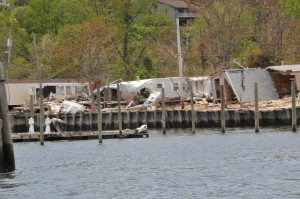
Damage caused by Hurricane Sandy to the Atlantic Highlands marina where we conduct our research on Raritan Bay.
Hurricane Sandy made landfall along the coast of New Jersey on October 29, 2012 and caused major damage to both the New Jersey and New York coastlines. Although precipitation totals associated with the storm were less than predicted, Hurricane Sandy arrived close to spring high tide and created a record storm surge in Raritan Bay at Sandy Hook of >3.0 m. Hurricane Sandy is the largest Atlantic hurricane on record and the second-costliest Atlantic hurricane in history (behind Hurricane Katrina). Damage caused by Hurricane Sandy took several WWTPs offline in New Jersey, and raw sewage carrying high levels of fecal coliform bacteria, nutrients, and pollutants emptied into New Jersey’s rivers and estuaries, including Raritan Bay. We are currently analyzing the environmental impact of Hurricane Sandy on Raritan Bay water quality in the fourth year of our monitoring study.
We planned to carry out a controlled, in situ microcosm experiment in Raritan Bay to investigate the interaction of nitrate, ammonium, and ferrous iron in structuring phytoplankton assemblages in Raritan Bay on November 3, 2012. Unfortunately, this date was less than one week after Hurricane Sandy hit the coast of New Jersey. Because Hurricane Sandy completely destroyed the Atlantic Highlands Marina and damaged the boat we charter for our research, we were unable to complete the experiment as planned. This is the unfortunate reality of field work even for the most organized of folks! However, we were able to successfully complete this experiment on May 25, 2013. Yay!
